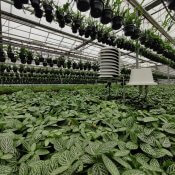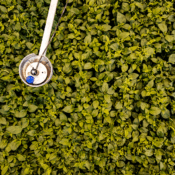Digital Twins: step-by-step
Digital Twins are a hot topic, increasingly making their mark in the horticultural sector. Curious about the current trends? We present a general step-by-step view of Digital Twins.
To start: what are Digital Twins? We define these as digital representations of reality, which can be used to monitor, experiment, and make predictions about several crucial greenhouse operations. This can mean a lot of things in practice: from models of intricate leaf responses tologistic operations.
In general, there are 5 key stages of Digital Twins that can be outlined:

Descriptive Twin
This first stage of a digital twin creates a digital representation of a system, without any live data and simulation possibilities. Think of a model of the construction of a greenhouse.
Informative Twin
This stage incorporates (live) data into the descriptive model, offering real-time monitoring and feedback. Think of the integration of climate, plant and soil data to represent the status in the greenhouse.
Comprehensive Twin
This stage provides insights from the twin. This means that the interpretation of the model and the data in it is no longer (just) up to the user, but the Twin can create its own suggestions. For example, the Twin can suggest whether your plants are leaning vegetative or generative.
Predictive Twin
Here, you can run simulations based on the Twin. Say you want to experiment with different lighting strategies, the Twin can predict what the outcome would be based on the greenhouse data and environmental predictions.
Autonomous Twin
The ultimate stage where the twin operates autonomously, making real-time decisions and adjustments to the greenhouse environment to ensure optimal growing conditions without human intervention.
These increasingly advanced Digital Twins have a high potential to revolutionise greenhouse operations. We are committed to making the horticulture industry more sustainable, efficient, and innovative. Together we can learn, grow and make this happen through technology.
Explore how we can collaborate to implement Digital Twin technology and stay ahead of the curve. Take a look at our Digital Twin propositions or book a call to discuss how to get started!


30MHz is typing… Our extended support team is ready to chat!
At 30MHz we think it’s important that our users can use our platform in an optimal way. At times you may have questions and you would like some help from our support team. Email and our support page filled with helpful articles were your go to’s. But we thought it was time for something extra… ...Read more
New 30MHz connect casing: How we protect your tech
To make sure your dataflow is fully protected, 30MHz introduces a new connect casing: waterproof, dust proof and even resistant to hits. This special shield will last longer and ensure a reliable dataflow from the connected sensor. What does that full protection mean? That’s what we will explain in this article. Watertight: resistant to wetness ...Read more
Most popular sensors for your greenhouse
As a grower, you know that optimal crop development starts with precise monitoring of your cultivation environment. But how do you transform raw data into actionable insights for your crops? This is where our wireless sensors and the 30MHz platform come together. Our sensors measure essential variables such as VPD, dew point, moisture deficit, EC, ...Read more


